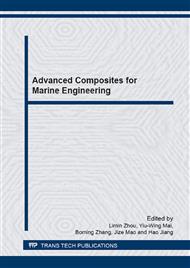[1]
A.P. Mouritz, E. Gellert, P. Burchill, K. Challis, Review of advanced composite structures for naval ships and submarines. Compos. Struct. 53 (2001) 21 – 41.
DOI: 10.1016/s0263-8223(00)00175-6
Google Scholar
[2]
S.E. Hellbratt, Experiences from the design and production of the Visby. In: Proceedings of Sixth International Conference on Sandwich Structure. Florida, March 2003, pp.281-304.
Google Scholar
[3]
H. Rack, M. Cohen, Strain hardening of iron-titanium alloys at very large strains. Mater. Sci. Eng. 6 (1970) 320–326.
DOI: 10.1016/0025-5416(70)90068-6
Google Scholar
[4]
Morris Jr J. In: Takaki S, Maki T, editors, International symposium on ultrafine grained steels. Tokyo (Japan): Iron and Steel Inst.; 2001, p.34–41.
Google Scholar
[5]
B. Arifvianto, Suyitno, M. Mahardika, P. Dewo, P.T. Iswanto, U.A. Salim, Effect of surface mechanical attrition treatment (SMAT) on microhardness, surface roughness and wettability of AISI 316L. Mater. Chem. Phys. 125 (2011) 418–426.
DOI: 10.1016/j.matchemphys.2010.10.038
Google Scholar
[7]
H. Gleiter, Nanocrystalline materials. Prog. Mater. Sci. 33 (1989) 223–315.
Google Scholar
[8]
A. Jerusalem, Radovitzky R. Modell, Simul. Mater. Sci. Eng. 17 (2009) 025001.
Google Scholar
[10]
L. Lu, Y. Shen, X. Chen, L. Qian, K. Lu, Ultrahigh Strength and High Electrical Conductivity in Copper. Science. 304 (2004) 422–426.
DOI: 10.1126/science.1092905
Google Scholar
[9]
L. Lu, R. Schwaiger, Z. Shan, M. Dao, K. Lu, S. Suresh, Nano-sized twins induce high rate sensitivity of flow stress in pure copper. Acta Mater. 53 (2005) 2169–2179.
DOI: 10.1016/j.actamat.2005.01.031
Google Scholar
[10]
A. Jerusalem, M. Dao, S. Suresh, R. Radovitzky, Three-dimensional model of strength and ductility of polycrystalline copper containing nanoscale twins. Acta Mater. 56 (2008) 4647–4657.
DOI: 10.1016/j.actamat.2008.05.033
Google Scholar
[11]
J. Frontan, Y.M. Zhang, M. Dao, J. Lu, F. Galvez, A. Jerusalem, Ballistic performance of nanocrystalline and nanotwinned ultrafine crystal steel. Acta Mater. 60 (2012) 1353-1367.
DOI: 10.1016/j.actamat.2011.11.029
Google Scholar
[12]
A.Y. Chen, H.H. Ruan, J. Wang, H.L. Chan, Q. Wang, Q. Li, J. Lu, The influence of strain rate on the microstructure transition of 304 stainless steel. Acta Mater. 59 (2011) 3697–3709.
DOI: 10.1016/j.actamat.2011.03.005
Google Scholar
[13]
Y. Lin, J. Lu, L. Wang, T. Xu, Q. Xue, Surface nanocrystallization by surface mechanical attrition treatment and its effect on structure and properties of plasma nitrided AISI 321 stainless steel. Acta Mater. 54 (2006) 5599–5605.
DOI: 10.1016/j.actamat.2006.08.014
Google Scholar
[14]
H. Zhang, L. Wang, Z. Hei, G. Liu, J. Lu, K. Lu, Low-Temperature Plasma Nitriding of AISI 304 Stainless Steel with Nanostructured Surface Layer. Z Metallkd. 94 (2003) 1143–1147.
DOI: 10.3139/146.031143
Google Scholar
[15]
G.R. Johnson, W.H. Cook. A constitutive model and data for metals subjected to large strains, high strain rates and high temperatures. In: Proceedings of the seventh international symposium on ballistics; 1983. The Hague, Netherland. p.541–547.
Google Scholar
[16]
W. Dabboussi, J.A. Nemes, Modeling of ductile fracture using the dynamic punch test. Int. J. Mech. Sci. 47 (2005) 1282–1299.
DOI: 10.1016/j.ijmecsci.2005.01.015
Google Scholar
[17]
Z. Hashin. Failure criteria for unidirectional fiber composites. J. Appl. Mech. 47 (1980) 329–334.
Google Scholar
[18]
S.C. Tan, A progressive failure model for composite laminates containing opening, J . Compos. Mater. 25 (1991) 556-577.
Google Scholar
[19]
Information on http: /www. hexcel. com.
Google Scholar
[20]
Abaqus 6. 10 Documentation. Providence, RI, USA: Dassault Systemes Simulia Corporation, (2010).
Google Scholar


